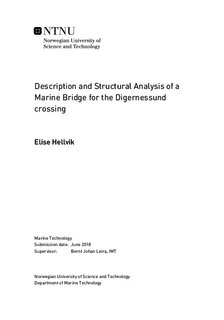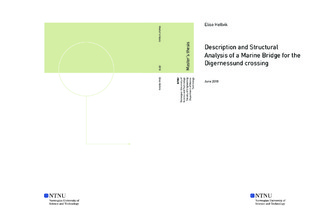| dc.description.abstract | The relevance of marine bridges have increased during the past years due to the plans of renewing route E$39$. Different types of marine bridges have been described in this thesis, with focus on the concepts proposed for the fjord-crossings along route E$39$. The existing bridge over the Digernesund does not meet the new requirements for the new E$39$, and a submerged floating tunnel (SFT) has therefore been proposed as a replacement. The proposed SFT, given in the technical report provided by dr. Techn. Olav Olsen, has been investigated in this thesis with respect to its structural behaviour.
The SFT proposed by dr. Techn. Olav Olsen is a reinforced concrete structure with post-tension cables. The cross-section used in this thesis is rectangular, and the bridge has one single span including both driving directions. There are no intermediate supports, meaning the bridge is only supported by buoyancy and the connections to rocks tunnels at the two ends. The model and structural analysis of the SFT were established and conducted in the Sesam package. The bridge was modeled as an assemble of straight $2$-node beam elements creating an arc. The influence of reinforcements and post-tension cables were accounted for in the bending stiffness of the structure, in the stress calculations and in the eigenvalue analysis. The average increase of moments of inertia is 3.89\% for $I_{z}$ and 3.24\% for $I_{y}$. The axial compression from the PT-cables was calculated 5.75\% of the Euler buckling load. Thus, global buckling was not considered a problem for the base case configuration of the bridge.
Buoyancy was found as the dominating load in the vertical direction for the base case. The results from static analysis showed high reaction forces to be transferred to the abutments and high bending moments. The stress calculations showed that the maximal total compressive stresses were below the allowable limit. However, the tensile stresses from the characteristic loads exceeds the tensile strength of concrete. Thus, the weight should be increased to balance the buoyancy. A full calculation of the amount of reinforcements should be carried out and its contribution included in the weight calculations. An alternative could be to increase the ballast chamber fill percentage to increase the weight. The transverse reactions are dependent on the current direction and profile. Different directions and profiles were investigated with respect to static response. The cases of applying uniformly distributed current loads to the full length of the bridge, in either the positive or negative transverse direction, gave the highest bending moments and axial forces in the structure. It was found that the contributions in stress from axial forces and bending moments due to current loads are small compared to the contributions from PT-cables and the net vertical forces.
Eigenvalue analyses were conducted using Sestra and Abaqus, and the results were compared to results from analytical calculations. The resulting mode shapes were similar to those given in the technical report established by dr. Techn. Olav Olsen. The eigenperiods calculated by Sestra and Abaqus deviates from the calculations by the NPRA by about 10-20\%. It is assumed that this deviations can be a result of differences in modeling and assumptions for the eigenvalue analysis. The eigenfrequency for the first mode is multiplied by a reduction factor to account for the influence of the compression force from the PT-cables. The first eigenperiod for the base case was thus calculated 9.14s. The second eigenperiod, corresponding to a horizontal mode with one half-wave, was calculated 5.16s by Sestra. The third and forth eigenperiod, corresponding to vertical and horizontal mode with two half-waves respectively, were calculated 3.34s and 3.00s by Sestra. For increasing mode number, the eigenfrequencies were closely spaced.
A parameter study of the curve height in the transverse direction were also carried out. Increasing curve height influences the static response, the eigenfrequencies and the mode shapes. The main findings were that the transverse loading is carried by axial forces and bending moments, as expected. Increasing the curve height results in reduced bending moments due to transverse loads. However, it also results in increased torsion moments due to the translation of centre of gravity along the y-axis. For eigenvalue analysis, the first horizontal mode is of interest when introducing a curve height. The result is reduced eigenfrequency for increasing curve height. At one curve height, it was expected that the first and second horizontal mode shape changes place. The curve height corresponding to the changing point was calculated 49m analytically, 53m in Sestra and 56m in Abaqus.
Swell sea was the dominating wave type at the depth of the SFT. The submergence of the tunnel provides shelter from the wave loads as the wave action at the depth of the SFT is 35.8\% of the wave action at the free surface. Wave loads due to swell sea were calculated using deterministic wave load calculation in Wajac. The dynamic response was calculated using direct time domain analysis in Sestra. However, the dynamic response due to swell waves was found to be of second importance compared to the response from static loads. Displacements due to the swell waves investigated in this thesis were found negligible compared to the results from static analysis. The bending moments due to swell waves were calculated 6\% of the bending moment from net static loads. To ensure conservatism in stress calculations, the bending moments from wave loads should be included. | |

